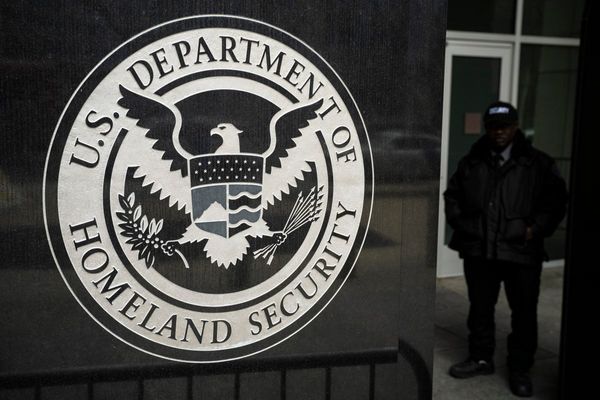Undocumented and disabled, the members of the Living Hope Wheelchair Association offer a vision for a more caring future.
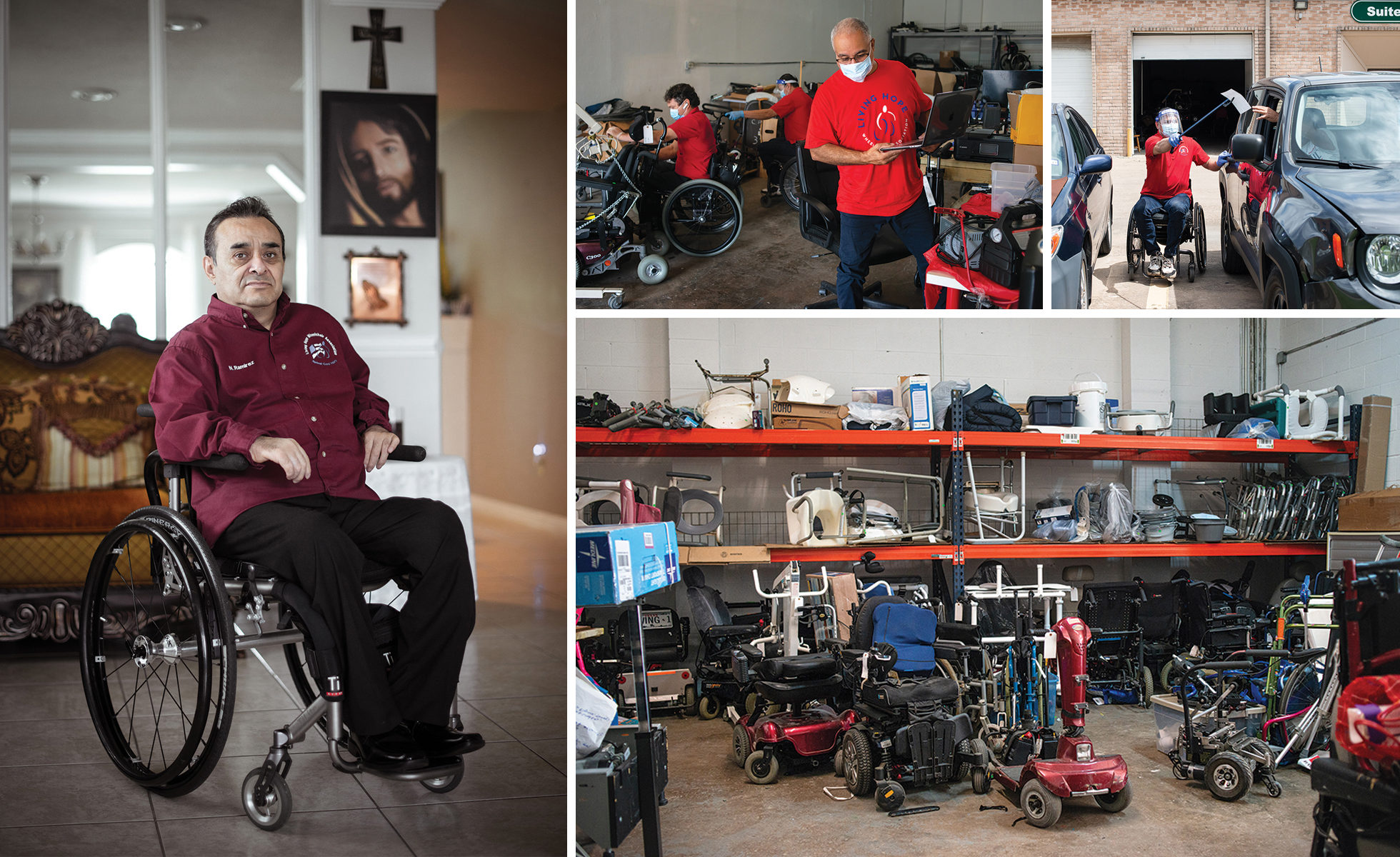
By Kimberly Meyer
October 5, 2020
Fernando Ramos arrives late to the community center, wheels in, and picks up a guitar, joining his voice with the others: Entre tus manos, está mi vida, Señor. From his wheelchair, Noé Ramirez directs the group. Francisco “Pancho” Argüelles strums a guitar as he stands. Others sit in their wheelchairs and play instruments. A couple of the women sing—Hay que morir, para vivir—their voices clear and powerful, if slightly off-key.
Across the barren conference room, a plastic folding table, covered with a brightly striped woven serape, serves as an altar for Día de los Muertos. The ofrendas are simple: a few photos of those who had been lost, a small wooden shadowbox with its own miniature altar hung with papel picado and laid with skulls, a vase of paper flowers, an icon of the Virgin of Guadalupe. Strewn on top of the serape are yellow sticky notes covered with names—Maria, Mario, Armando, Elvira. Or just mi mamá, mi esposo.
It’s the November meeting for Living Hope Wheelchair Association, a group of mostly undocumented immigrants in Houston who have suffered spinal cord injuries, many while supporting the city in one way or another—laying its roads, mowing its yards, cleaning its houses, feeding its hungry, caring for its children and elderly.
Ignacio Barrera (Barrera’s, Ramos’, and other names have been changed to protect their identities) offers the opening prayer, asking for blessings and wisdom to do their daily work, remembering those who couldn’t be there with them. Then, after the songs, they turn to the day’s business: fundraising, petitioning City Hall, discussing the need to care for their aging members.
According to a report published in May by the Baker Institute at Rice University, undocumented immigrants contributed around $2.43 billion in tax revenue to the state of Texas in 2018. And yet the undocumented don’t reap many of the benefits that those taxes pay for. If they are injured here, they are largely out of luck.
It’s hard to imagine a more vulnerable or a more marginalized population than the members of Living Hope. Still, abandoned by agencies both local and federal, they have banded together to form a mutual aid society that helps provide the equipment and supplies they need to survive day by day, along with the emotional support and sense of community that gives their lives meaning. Since forming in 2005, they have also organized themselves to protest against the systems of injustice that make their lives and their health so precarious. And now, in the midst of a global pandemic affecting the vulnerable and marginalized most of all, they are uniquely poised to help us reimagine the world as it could be on the other side.
After they conclude their business, members sing “Happy Birthday” to Ramirez, the president of Living Hope. Argüelles pulls out a harmonica. Ramirez, 52, wears sleek tracksuit pants, a red Living Hope polo shirt, and black fingerless gloves that protect his hands as he pushes the tires of his wheelchair. In Mexico City, where he is from, Ramirez owned a taxi and played guitar in a trio on the metro trains as they emptied and filled with commuters. In 1997, he crossed the border by holding onto the undercarriage of a rail car as it skimmed the tracks. He landed in Houston, got a job at a restaurant, and planned to work for a year to save money to buy a new taxi back home to support his wife and daughter. Early one morning, 10 months in, he was hit by a car as he rode his bike to work downtown. The woman who hit him kept driving.
His wife and, later, their young daughter managed to make their way to Houston to help care for him, but Ramirez faced other obstacles. He couldn’t afford private health insurance. Even if he’d been injured on the job, without legitimate papers, he wouldn’t have been able to get workers’ compensation. And under President Bill Clinton, Congress had recently passed the Personal Responsibility and Work Opportunity Reconciliation Act—otherwise known as welfare reform—which barred all undocumented immigrants like him from Medicaid.
For rehab, doctors sent Ramirez to the county-run Quentin Mease Community Hospital, part of the Harris County Hospital District (now called the Harris Health System), which didn’t ask for proof of citizenship. There, he met others with spinal cord injuries who were also undocumented, and they joined together in an informal support group.
For a while, every month, they would receive treatment from the clinic as well as essential supplies—diapers, catheters, urine drainage bags, gloves, lubrication. These supplies would have cost them, out of pocket, upward of $400 a month. Then, in 2005, the Harris County Hospital District ended the distribution of medical equipment and supplies for the non-Medicaid eligible population, which by then included noncitizens. And that’s when Living Hope began.
Before the November meeting closes with a shared meal of homemade pozole, the group holds a baby shower for Andrea Seguar, whose second child is due soon. Seguar, who came to the U.S. from Honduras with her father in 2003, when she was 17, had been paralyzed when her husband cut her throat with a knife. With the guidance of Argüelles and Living Hope, she was able to get a U Visa for victims of crimes who have suffered mental or physical abuse while in the United States, and she eventually divorced her husband. “I see this organization as a net that is able to catch and to sustain our own community,” Argüelles says.
As Seguar opens up the gifts—fleece blankets, snuggly outfits, packs of tiny socks, an envelope filled with cash—one woman calls out to Seguar, laughing, “Your baby will have lots of aunts and uncles.”
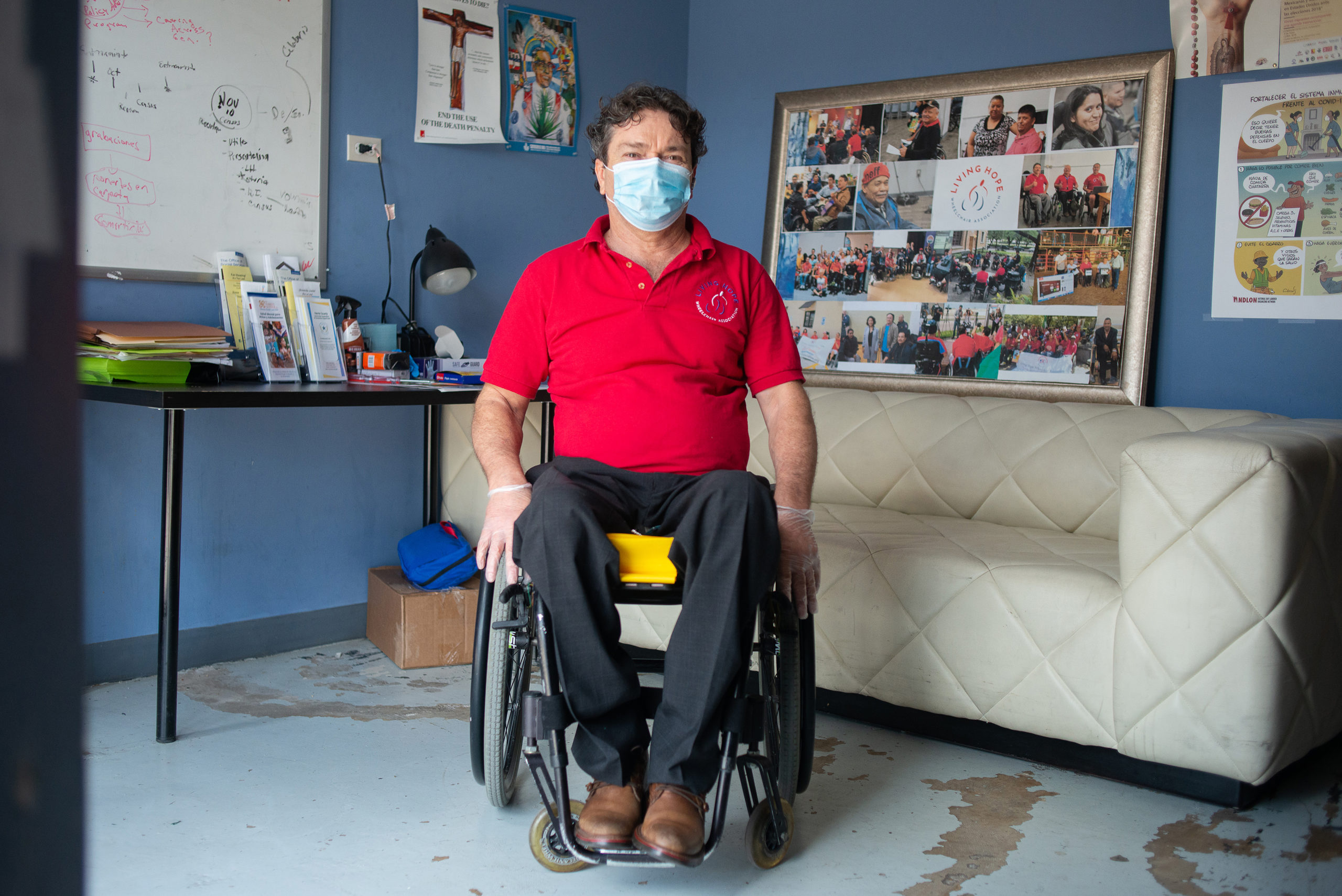
The informal group that had begun at Quentin Mease moved to the Metropolitan Multi-Service Center on West Gray, a recreation center run by the Houston Parks and Recreation Department for people with disabilities, and started fundraising. They sold roses on street corners and at intersections. They held car washes. Friends would donate TVs or microwaves or blenders, and they’d raffle them off at churches like San Carlos Borromeo, north of the city in a neighborhood of taquerias and carnicerias and yerberias. Using the money they earned, they’d buy supplies in bulk and divvy them up among themselves. Technically, they needed something like 180 catheters a month—each. But they could collect only enough money to buy and distribute 15 or 20 a person. They’d wash and boil the catheters and reuse them, but this would often lead to infections. Still, says Ramirez, “we always said we were never going to leave anyone behind. And until now, we’ve kept true to our word and no one has ever left with their hands empty.”
From the beginning, they understood that their real purpose was not merely supply distribution. It was solidarity, a political act, a form of protest against their marginalization. They were undocumented, so speaking up and asking for help was dangerous. But as immigrants who had been discarded by the state they had helped to build, they felt they could not be silent.
That’s what drew Argüelles to the group. Back in 1983, Argüelles, now 55, spent a year volunteering with a friend in an Indigenous Mayan community in Chiapas—20 families on the side of a mountain with no roads, no electricity, no running water. The people there were, Argüelles says, the anawim of the Bible—the poor and excluded—“the people who have no meaning for the system,” as he puts it. “God is on the side of the poor, and God doesn’t want injustice,” Argüelles says. “And so the job of the people of faith is to work for justice.” In those years, this thinking, known as liberation theology, ran like a current throughout Latin America, among nuns and priests and laypeople. Bishop Samuel Ruiz, who led the diocese in Chiapas, called the work they were doing among the anawim acompañamiento—accompaniment.
Argüelles would go on to do this kind of organizing work among Guatemalan refugees who had crossed the border into Chiapas and among farmers in Nicaragua. He helped organize collectives and small credit unions in the mountains outside Mexico City. When he moved to Houston and met the members of Living Hope in 2006, those organizing skills were what they needed.
There was something exceptional about the group—something connected to their vulnerability and their persistence, Argüelles says. Like the Mayans in Chiapas, they were the anawim, the excluded. And they had suffered a great injustice. They had literally broken their backs working in Houston, the medical capital of the world, and had then been forced to fend for themselves. “You all have a powerful moral authority that this society really needs to hear,” he would tell the group as he began helping them to organize. With Argüelles’ help, they formed a nonprofit organization. He came on officially as a part-time executive director in 2011, when they received a national grant from the Catholic Campaign for Human Development. They realized then, Argüelles remembers, that this money would allow them “to change systems, to plan more, not just to improvise. And for me it was like, OK, let’s build really collective leadership.’”
On distribution day in October 2019, the second Wednesday of the month, the door of the unmarked Living Hope warehouse is rolled up. Fernando Ramos, 46, wheels back and forth between his laptop and an immense storage area stacked floor to ceiling with medical supplies. Behind him, volunteers, many in wheelchairs, open cardboard boxes and compile allotments of catheters, rubber gloves, and diapers.
Alejandro Rodríguez, 55, comes out of the adjacent Living Hope office, where the staff is eating chilaquiles and charro beans with sliced hot dogs. He has a Bluetooth in his ear, and as he maneuvers through the small crowd, he fist-bumps young guys in wheelchairs with tattoos and diamond-stud earrings. Rodríguez is tall and elegant. He and Don Manuel Guardado, 62, white-haired, stocky, and wearing an “I ❤ Texas” hat, oversee Living Hope’s medical equipment operation. They are like brothers, they say. Both are in the U.S. legally; both have driver’s licenses. Together they travel throughout the city in the Living Hope van picking up donations of used medical equipment. Back at the warehouse, they clean and repair and store everything. And then the organization gives it away.
At its core, Living Hope is a mutual aid society, dispensing equipment and supplies to its members while providing emotional support. In 2018, the group distributed almost $110,000 in medical supplies and $28,000 in medical equipment. Its “Quality of Life Promoters” committee goes to hospitals and homes to meet with people in their early days of crisis, to try to talk them through the trauma and to advise them on practicalities and on their rights. Hospitals and social service agencies now regularly refer the uninsured and the underinsured, both U.S. citizens and the undocumented, to Living Hope.
Like Shyrl Potts, 61, for example, a Black woman propelling herself now through the warehouse with her walker, greeting everyone with a huge smile. She has a trach tube in her neck and is stylish in fur-lined black suede shoes and a leopard-print sweater. Everyone knows her as Mrs. Potts. Mrs. Potts is at Living Hope today because of Hurricane Harvey. In 2017, the house she and her husband were renting had flooded and they’d been evacuated by boat. They lost everything. But particularly difficult to replace was all the medical equipment—breathing machine, suction machine, oxygen tanks, electric wheelchair, manual wheelchair, walker. When they finally got settled, months later, “I was calling around,” looking for help, she says, “and everyone was saying no.” Finally, someone referred her to Living Hope, and when she showed up one Distribution Day a couple of months after Harvey, members gave her a wheelchair, a walker, and a bathtub seat. And they enrolled her in their monthly medical supplies program.
After Mrs. Potts became a member of Living Hope, Ramirez and others would call to check up on her and her husband. This is Argüelles’ accompaniment at work. It meant a lot to her. “They don’t know me—me, me,” she explained. “They don’t have to do that. It seems like a little thing, but to me, when they give me that, that’s taking care of me. That makes me feel special.”
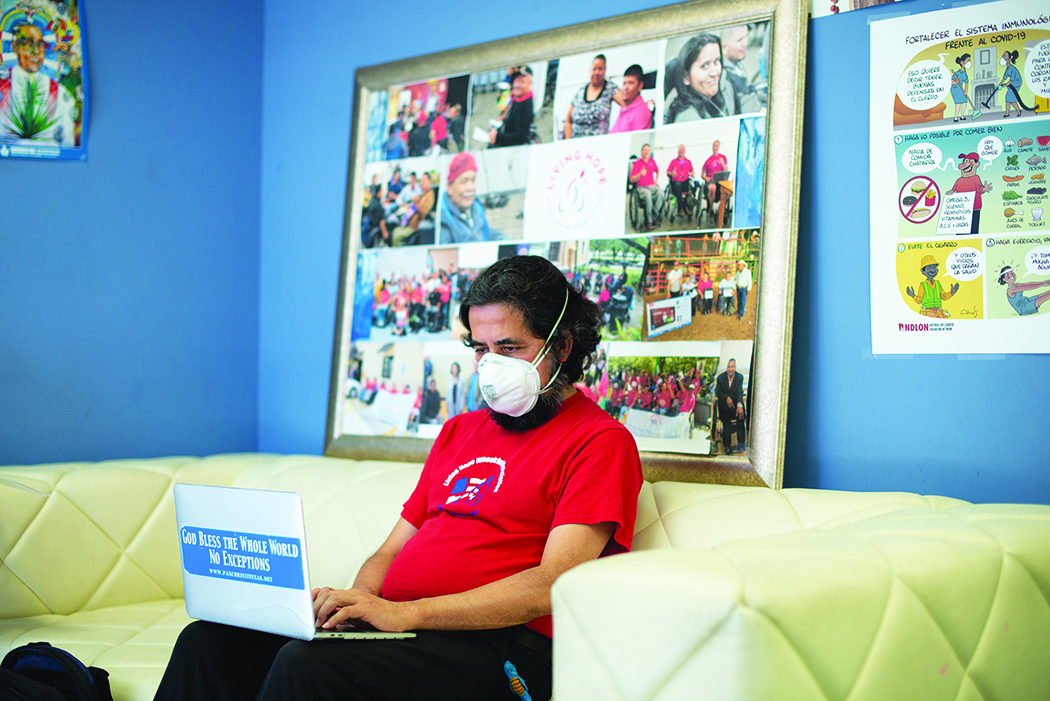
Over the years, living hope has become increasingly engaged in politics. Members have marched in May Day parades in support of the DREAM Act and DACA. They’ve been to the Texas Capitol in Austin to protest Donald Trump’s executive orders.
The organization’s political work makes it unique in the nation, says Tomás Aguilar, the disaster recovery coordinator for Living Hope and the organization’s only full-time employee. (The leadership staff are all volunteers who receive small quality-of-life stipends.) There are organizations that deal with disability rights and organizations that deal with immigrant rights, but not both. Aguilar says when you’re disabled and undocumented and “you’re trying to agitate, trying to change the rules, not just live within them, that’s [where] there’s not many people like us.”
But although Living Hope has long been politically engaged, the group’s work during Hurricane Harvey gave it a mandate to speak more broadly about the systemic injustices they saw as they worked on recovery efforts, says Leonardo Valenzuela Pérez, a researcher with the Unitarian Universalist Service Committee, based in Cambridge, Massachusetts, which has been partnering with Living Hope on disaster response. In the months following Harvey, Living Hope received $100,000 in aid from national organizations as well as from many individual online donors, which it distributed to members, along with medical supplies and equipment, food, and household items. During their initial recovery efforts, members saw, for example, the way that emergency information often didn’t reach immigrant populations. Or that when the disabled arrived at shelters, those shelters were not always equipped to accommodate them. Later, they saw that some damages, while catastrophic—whole trailers or mobile homes rendered uninhabitable, wheelchair ramps swept away—didn’t meet the minimum dollar amount to receive aid. Or that those who lived in apartments covered with mold could not complain to their landlords because they feared deportation.
In a 2019 report, Aguilar, Argüelles, and other Living Hope members argue that those whom the Living Hope team encountered in their work post-Harvey were suffering not because of the hurricane, but because they were poor and brown. Structural racism was, they say, a kind of preexisting condition that deepened the disaster.
Living Hope’s response to Harvey had a profound impact, not only in getting life-saving aid to its disabled and undocumented members, but also in giving the organization a place at the table. “Before [Harvey], they were seen as a very marginal group,” Valenzuela Pérez says, “but then they showed what you can do if you inject resources there.” Still, the organization’s work is about more than effectively allocating resources, he points out. “They are creating community among people who are usually left out of the community. They bring in the ones who are at the margins out of the margins.”
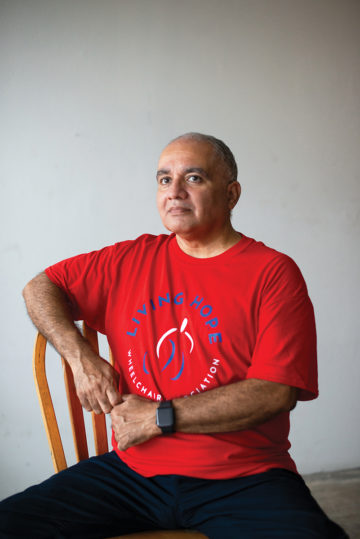
And now, Living Hope wants to bring the marginalized to the center, to challenge the systems that put them there in the first place. “Imagine a culture, a society,” Aguilar says, “where people with disabilities, people that speak other languages, people with different documentation status, older people that can’t move fast and may not be quick to respond, the children that come with all these families … imagine when we do budgeting, planning, imagine that these populations were there from the beginning and not an afterthought.”
In August 2019, Living Hope organized a conference on disaster preparedness and response. Representatives from the offices of County Judge Lina Hidalgo and U.S. Congresswoman Sylvia Garcia were there, as was a broad array of community partners—the Harris Health System, Rice University’s Kinder Institute for Urban Research, Houston Immigration Legal Services Collaborative, preachers from Black churches.
The keynote address that day was given by Marci Roth, a former FEMA official in the Obama administration and, at the time of the conference, the CEO of Partnership for Inclusive Disaster Strategies. Roth spoke about the example that Living Hope is setting at the national level. “They are one of the few organizations anywhere, really getting it right for those individuals who are multiply marginalized,” she said later in a phone interview. “They play such an incredible role in assisting and also engaging as leaders the very folks who are so excluded, left behind by everybody else.”
In the midst of a global pandemic that has disproportionately affected the marginalized, the conclusion of Living Hope’s 2019 report reads like a prophecy: “A democracy that constantly marginalizes and ignores large sectors of its population is a democracy that diminishes itself.”
Or maybe it offers a blueprint for the new world that could be created out of the upheaval. Within a few weeks of the start of the shutdown in March, Living Hope had distributed two months’ worth of medical supplies along with food and hundreds of dollars in cash assistance to each member. The leadership meets daily by Zoom. “We are working every day to look for things to help our people,” Ramirez said in a recent phone call. Monthly meetings have continued online. Ramirez and other leaders also do regular check-in calls, dividing up the roster and going through it, then starting again. The depression and isolation so many members feel already has become only more pronounced in the era of COVID-19. The phone calls, the meetings, the food and the money and the supplies—they all help ease the pain.
“People are very thankful about what we are doing,” Ramirez said, “because they feel we care about them.” The work of Living Hope, he emphasized, is not merely transactional. Nor does it travel in only one direction, the leadership bestowing charity upon its members. “The work is everyone,” he said. “Because if it wasn’t for them, we are nothing, you know? The work is all of us.”
Read more from the Observer:
-
Erika Andiola Says Dreamers Know How to Push Biden: “All we can do is pick our opponent,” says Andiola, the chief advocacy officer for the San Antonio-based immigrant rights group RAICES Action.
-
Remembering a Jewish Upbringing in Meyerland, Texas: An excerpt from David Biespiel’s memoir A Place of Exodus.
-
State Officials Tried to Cut Women’s Health Care During a Pandemic. It’s a Clear Reflection of Priorities: The state health agency continues to propose cutting services for families while leaving fully intact a program that funds anti-abortion crisis pregnancy centers.
